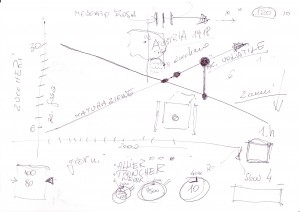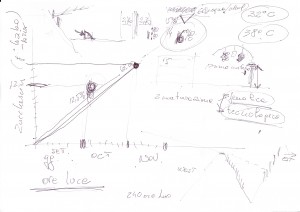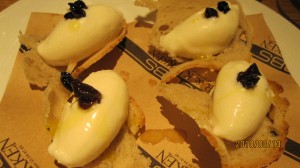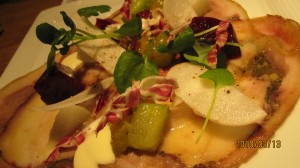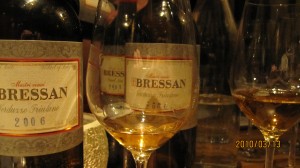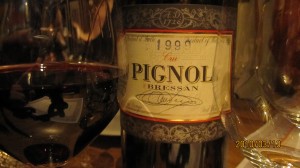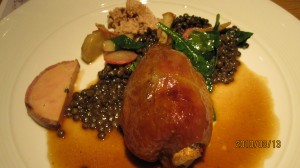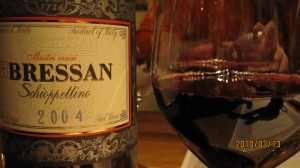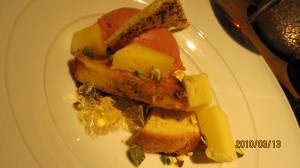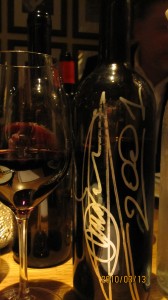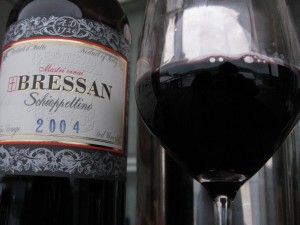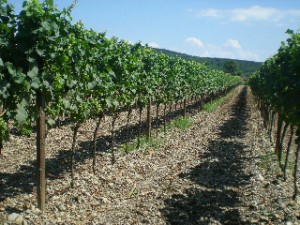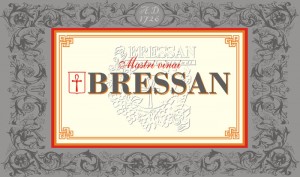In fact, one reason that I feel right at home here in Krakow is because it reminds me so much of Bergen, Norway where I now work (and lived for 8 years). No, the architecture is not the same (at all), the people are certainly not similar and the weather back in Bergen is not even remotely close to the glorious weather (by comparison) we have here in Krakow.
What is so similar to me is that Bergen has always crouched in the shadow of the country’s capital, Oslo. Oslo is where anything wine happens. Fairs, events, dinners, winemaker visits and it’s home to the majority of Norwegian wine importers. There is always an inherent wine struggle in Bergen, and I feel that the Krakow-Warsaw scenario is much the same.
But things are looking up in Krakow as I find it much easier as time goes by to find wine that I can actually consume, so thank you!
Le Due Terre is a producer I know little about except that the producer is from Friuli in the North Eastern tip of Italy and that they produce low-intervention wines – the sort of wines I love to drink. I had tasted their wines on less than 5 occassions, so when we were presented with a magnum of Schioppettino («the little fire cracker» in Italian), we paid no notice to the 2002 vintage stamped on the front label. Schioppettino is a grape I have come to love due to it’s extreme freshness and peppary mouthfeel, so I was looking forward to this double-sized dose! Here’s my brief tasting note:
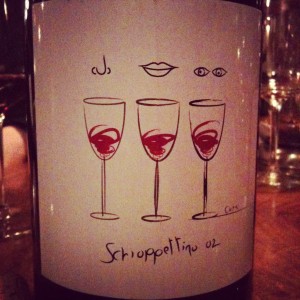 Date Tasted: March 3rd, 2012 20:30
Date Tasted: March 3rd, 2012 20:30
Appearance: Still youthful with barely a hint of obseravable age
Nose: Again youthful. Barolo-esque with hints of forest leaves and sour cherries.
Palate: Elegant, focused, light and long. Inky. Bitter almonds. The very delicate green hints (perhaps a vintage trait) help to actually lift the wine giving it added freshness. With some time in the glass, my thoughts of Barolo drift away as the wine starts to resemle a wine from Cornas, with it’s elegant focus, light pepper hints and loads of acidity.
This is overall a very elegant and delightful wine with tons of drinkability, in fact I believe that the magnum disapperared within an hour.
*This post was written especially for Winicjatywa and translated to Polish language here
]]>It’s been 6 years since the release of this movie and everyone still talks about Pinot Noir. In fact, to most wine connoisseurs, there is no more seductive grape than the Pinot Noir. We knew this before the movie, and we still know it today. I too am a sucker for the great Burgundian Pinot Noir. It’s a grape that can truly seduce with aromas of raspberries, cherries, forest floor and even flowers. The Pinot Noir’s high acidity gives the wine freshness and longevity. When you drink a truly great Pinot Noir, it can make you smile.
This being said folks, it’s time to move on and say “I’m not drinking any fucking Pinot Noir!” It’s time to give other (red) grapes a chance. Other grapes that I often look to to seduce me and make me smile! Even getting me to jump out of my chair! So what grapes am I talking about? Which grapes am I drinking most often these days?? Read ON!!
What about Gamay? Gamay finds it’s home in a few areas (mostly) in France and in the hands of the right grower, can seduce. Clos Roche Blanche in the Loire. Jean-Marc Brignot , Jean Foillard, Clos des Vignes du Maynes & Jean-Paul Brun (to name only a few) in Burgundy. I’m told that Edmunds St. John also makes an interesting Gamay in California, though I have not yet tasted it. The Gamay-based wines are incredibly fresh, dominated by red fruits and hints of spice. Thanks to the low(er) alcohol often found in these wines, their drinkablility is beyond compare!
What about Pinau d’Aunis? Found in the western parts of the Loire Valley, this once noble grape is slowly making a comeback thanks to Domaine Griottes, Clos Roche Blanche (try their Rosé!) & Jean-Pierre Robinot to name a few. With it’s truly seductive (and unmistakable) aromas of pencil lead, grapefruit and incense-like aromas, these incredibly fresh and light wines seduce me every time and this grape is quickly climbing to the top of my favorite (red) grapes list.
What about Schioppettino? Found in the far reaches of Friuli (near the Slovenian border), and until more recently, an unheard of grape for me. Then along came Fulvio Bressan with his “little firecracker”, the Schioppettino. Dominated by black pepper, minerals and black fruit while remaining fresh, this certainly is a grape to put on your top list of grapes to try!
What about Poulsard? Mainly found around the town of Pupillin in the Jura (just east of Burgundy), this thin-skinned red grape produces light colored wines which can be a bit reductive at first. Once open, brilliant, high-acidity and red fruit mark these delicate wines. These wines are a great fit for the local charcuterie & smoked sausage. Try the wines of Jean-Marc Brignot, Tissot and Overnoy to get a good taste for what this red grape can produce!
And let’s not forget the Nerello Mascalese! This Sicilian (Mt.Etna) grape is responsible for making wines like Frank Cornelissen’s Magma and Munjebel Rosso. Aroma’s that fit nicely between the Pinot Noir and Nebbiolo grapes. Aromatic wines with loads of freshness and solid tannins. Certainly not a grape to pass up if you have the opportunity to taste it. Great potential for aging – if you’re into that.
So, it time to starts saying “If anybody orders Pinot Noir, I’m leaving!” and time to start tasting some new grapes! Tell me about your favorite red grape(s)?
]]>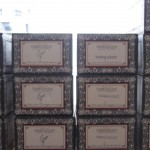
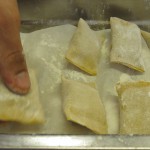 Event: Bressan Wine Maker Dinner
Event: Bressan Wine Maker DinnerRestaurant: Jacob’s Bar & Kjøkken
Date: Saturday, March 13th 2010
Host: Fulvio Bressan, Vinosseur, 213 W Wine Imports
I have done a producer profile on Bressan in past posts, but nothing I have written could have prepared me for such a down to earth warm person such as Fulvio. Energetic and outgoing, Fulvio entertained everyone at our table and the other tables as we made our rounds to introduce him to our guests. I thought I was going to have my work cut out for me with the translating from Italian, but it turns out that Fulvio’s grasp of English is very good, making my job a little easier. The turn out was better than anticipated with a completely full restaurant with even a few tables being turned.. for quaint little Bergen, this is quite a feat!
Bressan not only entertained the guests’ questions, he even managed to sneak over to the bar guests who stopped in after the local football (soccer) game and befriend them! Behind this outgoing, down to earth person, lies an amazing wine maker, even more amazing is his approach to viticulture. Although he is as natural as he can be, their is a lot of science going on here, especially when it comes to harvest. The effect that the harvest of healthy grapes has on the final wine is tremendous! In fact, harvesting even one day “too soon” or one day “too late” can make a significant difference on the final wine. (click on the images below to enlarge)
 Fulvio spoke of how much one or two days effect the maturity of the grape, what climate does to the maturation curve (sugar versus phenolic maturity), volatile acidity relating to date of harvest, and hours of light exposure effecting grape maturity. He even spent a few minutes discussing oxygen exchange differences between different size oak barrels, the smaller the barrel, the thinner the wall diameter, the greater the oxygen exchange (and oak influence). The most important thing to understand here is that most of his science, and the most important part of it, is out in the vineyards – especially when it comes to the exact date to harvest – probably the single most important. He also mentioned that the only thing he does out in the vineyards is the copper and sulfur treatment, but never after the 31st of July. And, he never harvests before it has rained, so that the grapes can be rinsed.
Fulvio spoke of how much one or two days effect the maturity of the grape, what climate does to the maturation curve (sugar versus phenolic maturity), volatile acidity relating to date of harvest, and hours of light exposure effecting grape maturity. He even spent a few minutes discussing oxygen exchange differences between different size oak barrels, the smaller the barrel, the thinner the wall diameter, the greater the oxygen exchange (and oak influence). The most important thing to understand here is that most of his science, and the most important part of it, is out in the vineyards – especially when it comes to the exact date to harvest – probably the single most important. He also mentioned that the only thing he does out in the vineyards is the copper and sulfur treatment, but never after the 31st of July. And, he never harvests before it has rained, so that the grapes can be rinsed.
Enough said, now on to the dinner and the pairings!
****
AMUSE BOUCHE
****
FIRST COURSE
PAIRED WITH
Comments: The delicate dried apricot aromas in the wine matched perfectly with the compote.
****
SECOND COURSE
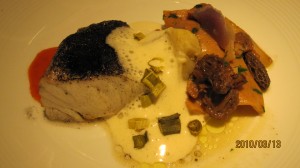
Baked Saithe with Blackened Leek, Crispy Spring Onion, Artichokes and Scallop and Mushroom filled Ravioli
PAIRED WITH
Comments: When I spoke to Fulvio on the phone about pairing his Pignol with a fish dish, he thought we were crazy. When he tasted the dish, he was stunned! The combination of fish, burned leeks and mushrooms created the link between the wine and the dish.
****
THIRD COURSE
PAIRED WITH
Comments: The pepper notes in this wine and good acidity paired especially well with the green lentils and liver
FOURTH COURSE
PAIRED WITH
Comments: Although I rarely use a dry red wine with cheese, this wine was great with the cheese and tomato sorbet (slightly sweet). We got mixed reviews on this dish. Many guests expected the “dessert” to be something sweet, rather this was an Umami filled dish which was for many of us at our table, one of the best pairings of the meal.
]]>
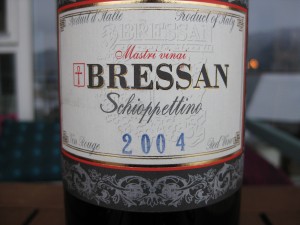 The Schioppettino is a red grape grown predominately in the Friuli-Venezia Giulia region of Italy. Also known as the Ribolla Nera, pills Schioppettino literally means “gunshot” or “little crack”. Records show that red wine made from the Schioppettino was used at marriage ceremonies back to 1282. The grape was nearly lost to extinction thanks mostly to the phylloxera epidemic. Today, Bressan is one of the few wine makers making wine from the Schioppettino grape.
The Schioppettino is a red grape grown predominately in the Friuli-Venezia Giulia region of Italy. Also known as the Ribolla Nera, pills Schioppettino literally means “gunshot” or “little crack”. Records show that red wine made from the Schioppettino was used at marriage ceremonies back to 1282. The grape was nearly lost to extinction thanks mostly to the phylloxera epidemic. Today, Bressan is one of the few wine makers making wine from the Schioppettino grape.
Soil composition: Calcareous mineral base, with high presence of iron sesquioxides. Such geological characteristics, associated with this scarce endowment of organic and other nutritional elements, forces the vines to a slow vegetative growth, resulting in an extremely low production, with an overall benefit to the MACRO and MICRO components of the grapes, and therefore the wines.
- Total surface area: 3.88 HA
- Planting year: 1982
- # of vines/HA: 3086
- Sun exposition: Southern, with rows oriented EAST-WEST
- Harvest: Permitted to slightly over-mature (so as to attain very high fixed acidity congenital to the species), harvested by hand.
Wine Making: Grapes are de-stalked and brought to must by way of soft-pressing; extremely long maceration with principal fermentation along with the grape skins, refrigerated with well water at a controlled temperature not exceeding 25C (77F). After racking, the wine undergoes an ulterior 35 days of fermentation. The wine is then stored in stainless steel tanks, followed by aging for at least 2 more years in 2000 liter oak casks. After bottling, groups of 500 bottles are placed in large chests, which are then stored in a temperature controlled warehouse for additional aging.
- Alcohol content: 13%
- Total acidity: 5.58 g/l
Date tasted: Saturday December 26th, 2009 12:02 (PM)
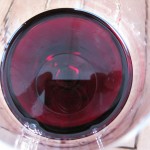
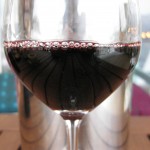 Appearance: Medium dark brick red. Very very slight development showing. Medium intensity.
Appearance: Medium dark brick red. Very very slight development showing. Medium intensity.
Nose: Very intense freshly ground black pepper. Blackberries and dark plums with mineral undertones. Floral and very intriguing. Hints of roasted meat. Forest floor, musk and wild fruit. Very complex and intriguing nose.
Palate: Very intense on the palate as well with aromas of black pepper, wild dark berries, musk and hints of red berries with a mineral background. Some pleasant dried fruit aromas as well. Medium tannins, medium to medium plus acidity carrying the wine to a long, very fresh finish. Very fresh and very drinkable. This has always been one of my favorite wines of Bressan.. Excellent with lamb!
]]>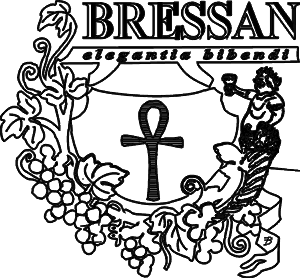 BRESSAN mastri vinai
Via Conti Zoppini, 35
34070 FARRA D’ISONZO (Gorizia)
Italy
Tel. +39 – 0481 – 888131
Fax +39 – 0481 – 889824
E – mail: bressanwines@tin.it
www.bressanwines.com
www.bressanwines.it
BRESSAN mastri vinai
Via Conti Zoppini, 35
34070 FARRA D’ISONZO (Gorizia)
Italy
Tel. +39 – 0481 – 888131
Fax +39 – 0481 – 889824
E – mail: bressanwines@tin.it
www.bressanwines.com
www.bressanwines.it
I haven’t done too many “producer profiles” so far, and I suppose that’s because I really have to believe in the philosophy of the producer before I feel compelled to write about them. Then, I really have to like the wines. I may have a favorite bottle, but overall, I tend to enjoy all of the wines the producer makes. Usually the wines will have a certain signature that says they all belong to a certain family – in this case we’re talking about the philosophy and wines of Mastri Vinai Bressan, and that signature is one of passion and patience. Patience enough to release a wine that, although is certainly age worthy, is actually ready to drink upon release. And this is why I have selected to write about Bressan.
The Bressan family owns about 20 hectares in the Friuili-Venezia Giulia appellation in North-Eastern Italy on the border to Slovenia. The first thing that struck me about this producer was of course the wines. Indigenous varieties that one does not taste every day, such as the Schioppettino, Pignol and Verduzzo Friulano. The second thing that struck me was the vintage of some of these wines which went back as far as 1999 (the latest release of the Pignol, for instance). The third thing that struck me was the philosophy of this producer. A philosophy very much in line with what I feel a wine producer’s philosophy should be.
The philosophy of the producer is very important to me. I focus mostly on wines that are organic, biodynamic and natural. It is not important to me if the producer is certified organic or biodynamic and I have said this before. After all, getting a certification is sometimes done for the wrong reasons. I am not excluding producers that ARE certified, I am just stating that an attitude and philosophy are in my opinion more important.
Fulvio Bressan says the following: ” I am not ‘organic’, even my own personal rules impose conditions in the vineyard and wine-cellar that are more severe than those of various ‘certifications’ “. He adds ” I am not bio-dynamic because I know unfortunately that the rules can be superseded by fashion and I know that nothing is easier than imposing rules and then breaking them, thus profiting from the naiveté of others… ” And, goes on to say ” The majority of wines produced today around the world are made mediocre, deprived of character, standardized, unable to challenge Time due to the indiscriminate use of chemicals both in the vineyard and the wine-cellar. This method of working deadens the traces of the grapevine, the features of the territory and the personality of the producer “. You can read more about his approach and philosophy here. It’s very interesting and worth a read!
And now on to the vines and wines. The wines of Bressan are made using only proprietary grapes. He does not sell or buy grapes. In fact, if the vintage is not a good one, Bressan chooses to simply let his grapes hang on the vines and fall to the floor and back into the soil in which they came. This way, nobody else can say they produce wines with the grapes of Bressan. His neighbors think he’s crazy, but he feels if his name is going to be on the bottle, it needs to be representative of his values. He says he will probably never get rich, but he will always be able to look into the eyes of people he has in front of him.
All the work they do in the vineyards and in the wine cellar is done with the maximum respect for nature, the grapes and the people who drink their wines (“wine should be a medicine not a poison as in many cases”). Here are the rules they have always followed:
- Manual selection of the vines and preferential use of indigenous varieties (cloning and all forms of genetically-modified organisms are forbidden)
- Pruning and removal of shoots is performed exclusively by hand
- Personal cultivation of the vineyard without the use of synthetic chemical substances, respecting vine and its natural cycles (total exclusion of herbicides and/or fungicides and/or pesticides)
- Exclusive use of natural fertilizers, from vegetables or from the barn, or else none at all
- Irrigation is forbidden even as relief, as water has always diluted the aromatic wealth and intensity of the wine
- The harvest is done manually to obtain perfectly healthy and mature grapes (no premature harvesting)
- Fermentation is obtained thanks to indigenous yeasts naturally present in the grape, absolutely excluding the use of synthetic industrial yeasts.
- No sulfurs anhydrides are added to the must, nor are other additives / chemicals (sulfurs anhydrides might be added only in small quantities at the moment of bottling and in any case in quantities that are lower or equal to biological certification)
- The use of biological and/or chemical aromas is forbidden
- Maturation of the wine in its own “fine lees” up to bottling
- No filtration (a practice which in any case always impoverishes and sterilizes the wine)
- Exclusive use of cork, rigorously limited to natural single pieces, so that each wine will have Time as its best ally
- Rigorously manual labeling (… each bottle is a unique creature… )
I will do complete tasting notes on 5 of Bressan’s wines over the next few days, so check back for some exciting wines and tasting notes!! Happy Holidays!!

